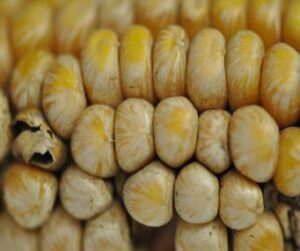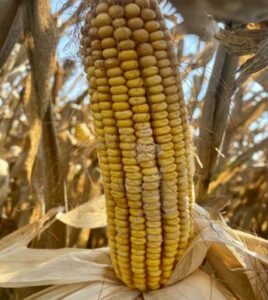Fusarium Ear Rot
Fusarium ear rot (FER) is the most common ear rot disease and is caused by several species of Fusarium, most commonly Fusarium verticillioides, F. proliferatum and F. subglutinans. F.verticillioides and F. proliferatum are associated with the production of the mycotoxin fumonisin.
Symptoms: Fusarium ear rot can appear as a white to peachy/purple, cottony mold, affecting individual or groups of kernels that are infected sporadically throughout the ear. Infected kernels are often tan or brown or have white streaks often referred to as a starburst pattern. This symptom is caused by the pathogen growing under the kernel pericarp. The symptoms of this disease vary according to genotype, climate, and disease severity.
Favorable conditions: Fusarium ear rot occurs under a wide range of weather conditions, but it is most severe under high temperatures (above 77ºF) and wet periods before harvest. Infection can occur through the silks, but insect or hail damage can result in wounds that help facilitate the pathogen. Although infection happens during silking, the fungi can continue to spread on infected ears past R6 stages and until grain moisture is below 18%. The optimum temperature for fumonisin production is 75ºF.
Yield penalty: Diseased grains will have reduced grain quality. In severe infections, ears may be completely consumed by the fungus leaving lightweight husks cemented to the kernels by mycelia. In the United States, it was estimated that the average annual loss due to fumonisins in corn is $40 million (Wu 2006).
Management: Fusarium species overwinter in seeds, plant debris and secondary hosts. Although seed transmission does not play a large role in ear rot development, cultural practices such as crop rotation and tillage may reduce inoculum from plant debris. In severely affected fields, aforementioned techniques might be ineffective due to airborne spores from neighboring areas. Corn varieties have different levels of susceptibility to Fusarium species. The management of ear-damaging caterpillar pest, such as the use of plant-incorporated Bt (Bt corn hybrids), can reduce disease infection and mitigate fumonisin.
Mycotoxins: Fumonisins are acutely toxic to animals, especially pigs and horses which cause porcine pulmonary edema and equine leukoencephalomalacia (ELEM, or blind staggers), respectively. In humans, fumonisins have been listed as potentially carcinogenic and associated with birth defects. As a result of these risks, the FDA has established advisory levels for the maximum amount that may be present in food and feed (TABLE 2).

